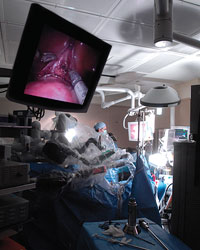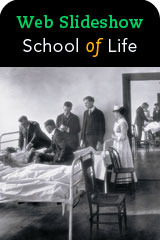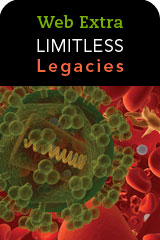Cancer Treatment and Transplantation Arrive in Alabama
By Caperton Gillett |
The opening of the Cobalt Therapy Unit, 1960. Photo courtesy of UAB Archives. |
When John Durant, M.D., came to the School of Medicine from Philadelphia in 1968 to start a cancer research and training program, he found “a medical center on a roll,” he says.
It was a time of great energy and expansion, particularly in cancer treatment and organ transplantation. These two fields would eventually help lead UAB to national prominence. But more important, the focus on cancer and transplantation meant that Alabamians would no longer need to travel hundreds of miles to other states for highly specialized, multidisciplinary treatment.
Comprehensive Cancer Care
Durant felt strongly that cancer patients would receive the best care in an academic medical center. At UAB, he used grants from the National Cancer Institute (NCI) and the Lurleen Wallace Courage Crusade—named for the late governor whose trips to Texas for care led to calls for an Alabama cancer center—to establish the cancer program. Research and treatment capabilities grew rapidly, and in 1971, the NCI designated UAB as a “comprehensive” cancer center—one of only 11 nationwide at the time and still the only one in a six-state region. Durant was its first director.
 |
Today, UAB uses robot-assisted surgery to treat head and neck, gynecological, and urological cancers. |
The current director of the Comprehensive Cancer Center, Edward E. Partridge, M.D., attributes the program’s growth—and its ability to provide specialized care for all types of cancer—to UAB’s strengths in translational research and emphasis on collaboration among departments. “The leadership made it clear that the only way that we, as a medical school in a relatively resource-poor state, could be competitive nationally was to work together,” he says.
The Cancer Center now has specialists in 12 clinical areas, including four federally funded Specialized Programs of Research Excellence for breast, pancreatic, brain, and cervical cancers. As a result, patients have unparalleled access to a variety of treatments, including clinical trials of breakthrough drugs. “Our mission is to provide high-quality cancer service to the men and women of Alabama and the region,” focusing on cancer treatment, risk management, and prevention, Partridge says. “We do that because we’re an institution that can field teams of specialists.”
Transplantation Trailblazers
 |
Arnold Diethelm performed Alabama's first organ transplants. Photo by Marc Bondarenko. |
Arnold G. Diethelm, M.D., came to the SOM in 1967, handpicked by John Kirklin, M.D., to help develop a surgery department. He jumped at the opportunity to help build the program from the ground up and to pursue his interest in organ transplantation. Alabama’s first kidney transplant took place a year later.
“The program began in a very modest way,” with four transplants in the first year, says Diethelm, now a professor emeritus. Over the next decade, the program evolved to incorporate pathology, radiology, and pediatrics.
The transplant program brought new treatment options to the many Alabamians suffering from kidney disease or kidney-related complications of hypertension and diabetes. “The reason there is a great deal of kidney disease in Alabama is unclear, but it’s a fact,” Diethelm says. “So there have always been a large number of patients in need of transplantation.” As a result, he says, UAB developed “a strong organ-procurement program—the Alabama Organ Center—which enhanced the number of patients we were able to transplant.” The kidney program was the basis for the heart, liver, lung, and pancreas transplant programs that followed throughout the 1980s.
Since the first kidney transplant, UAB has performed more than 10,000 organ transplants, making it one of the nation’s busiest programs. Research into organ rejection and preservation and new immunosuppressive agents enables UAB to offer transplant capabilities unmatched by other institutions. “Our greatest challenge is that the demand for transplants greatly exceeds organ availability. New programs to address this disparity include donor swaps and ABO-incompatible and desensitization protocols to deplete recipient antibody levels and allow successful transplant of organs that previously would have been rejected,” says Devin Eckhoff, M.D., director of the Division of Transplantation. “Our programs are known for their multidisciplinary teams and national leaders on both the medical and surgical sides who provide outstanding patient care.”
“There’s really only one place where you would start a transplant program in Alabama,” Diethelm adds. “UAB.”

